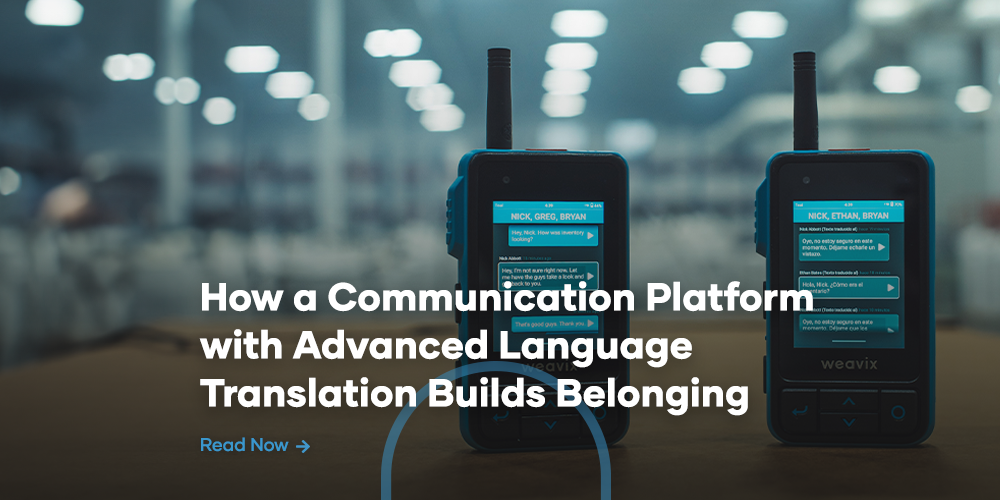A lot of thought and consideration goes into choosing the right network type for your enterprise. Whether you want the customization of a private LTE network or you’re more comfortable deploying wi-fi throughout your facilities, it’s best to understand the best and worst use cases for each type.
More than that, you want to know you’re making the best decision for your unique business needs and goals, and that your existing and future systems will be compatible. Using weavix™, our communication suite operates securely across all the network options discussed below. This gives enterprises the freedom to choose their network type and ensures they have a network that supports all their key functions now and in the future.
The four network options enterprises commonly choose between for their radio communications are private LTE, wi-fi, public wireless and land mobile radio (LMR). Knowing the costs, best uses, technology and more for each type will help make deciding which one is the right fit for your enterprise easier.
Private LTE for Enterprise
Recently, enterprises have opted for private LTE through the CBRS spectrum to support their communication and networking needs. This decision comes from many advantages private LTE has over the other network types, such as its security, customizable coverage and cost-effectiveness. Large enterprises, such as manufacturers, industrial complexes, highly industrial spaces and utilities have deployed private LTE networks and have seen great success.
Private LTE is more secure than other network options, with native integrity verification and data encryption methods in place to protect data. These added security measures make it very popular with information technology and cyber security professionals, especially in large corporations.
What workers unknowingly enjoy the most about private LTE is the customizable coverage it offers. Frontline workers often have to work in remote locations where connectivity is a challenge, like oceanic oil rigs or isolated mining facilities. With private LTE, carriers can build the network coverage to suit the needs of each location and is especially useful in these outdoor environments. Once it has been deployed and the location mapped out, reliable coverage for communications becomes available.
For enterprises looking to minimize their infrastructure expenses, private LTE is suitable. Even with the added security and customization, private LTE remains one of the most cost-effective network options available without sacrificing speed, reliability or latency for a growing number of devices, like the walt™ smart radio.
Taking all these benefits into consideration, weavix™ has made private LTE the preferred network option for deploying the Internet of Workers™ platform.
Wi-Fi Networks for Enterprise
Many have stated that private LTE for enterprise is on track to completely replace wi-fi as a leading network option for more industrial businesses. While this might be the case in some instances, wi-fi will not disappear from the business landscape anytime soon. New advances to wi-fi are currently being released, with the latest Wi-Fi 6 recording faster speeds and upgraded security than its predecessors.
Businesses outside of heavy industrial settings commonly use wi-fi to meet their networking needs. With a constant connection to electricity, a router can maintain the connection between multiple devices and the internet, so wi-fi is very suitable for indoor workspaces, such as an office building or retail space.
Enterprises using wi-fi still have fast speeds, low latency and a reliable connection, but it’s highly dependent on the chosen plan with your wi-fi carrier. Also, not every wi-fi connection is equally secure, unlike with a private LTE network.
The variable security measures with wi-fi networks put many businesses and enterprises at risk of a cyber-attack. This has resulted in enterprises spending an average of nearly 11% of their IT budget on cybersecurity, with that number increasing annually. While wi-fi networks do not have a uniform security measure, it is still a secure network option if the right precautions are in place.
Wi-fi continues to support the growing number of smart devices and cloud-based software in both office and frontline settings.
Using Public Wireless for Enterprise
Some enterprises have partnered with public telecommunication companies and service carriers to support their radio communication needs. While not completely common, these partnerships have provided comparable coverage, fees, security and speeds to enterprise communications as you’d see with your personal cellphone.
Public 5G wireless has a lot of the same advantages as private LTE, just without the customization that enterprises have benefited from. Public telecommunication companies own considerable amounts of the CBRS spectrum used to power private LTE networks through mergers, acquisitions and public auctions. Most commonly known as Band 48, the CBRS spectrum is divided into three tiers: one for incumbents and government entities, another for priority access license (PAL) users and the final tier for general authorized access (GAA).
While the CBRS spectrum is largely democratized, public carriers use their second-tier standing to improve their network offerings and expand coverage and speed to their customers, especially in high-traffic, densely populated areas. Private LTE users operate on the same spectrum as third-tier GAA users rather than second-tier PALs.
LMR for Enterprise
The fourth and final network offering for radio communication is land mobile radio (LMR) systems. Unlike our other network offerings described so far, LMR is an analog radio system that uses a series of short wavelengths picked up by two-way radio transceivers to communicate.
LMR is the original radio communication network, operating in the VHF and UHF frequency bands. When it was first developed, private entities used it to revolutionize push-to-talk radio communications, allowing workers to communicate with specific channels over longer distances using repeaters. LMR systems are still in use today; however, their large infrastructure needs, outdated technologies and high costs for deployment have made many enterprises reserve them only for radio communications.
weavix™ uses Radio over IP (RoIP) to connect an analog radio network, like LMR, to a digital network, like private LTE or wi-fi. This connection gives enterprises the best of both worlds, incorporating both to support their networking needs. With these networks working in unison, enterprises can experience digital communication capabilities without having to undergo a complete network overhaul.
When choosing your ideal network type, it’s best to keep in mind the needs of your enterprise and the goals you are hoping to accomplish. Your network can largely support your enterprise in a number of ways, so it’s vital to understand the full range of possibilities for each before you decide.
Private LTE is the preferred network option for weavix™, but your enterprise can choose between any network and still experience all that the Internet of Workers™ has to offer. To give your workforce the most advanced communication capabilities available, get started today.
Subscribe
Don’t miss out on industry news and information. Subscribe to interweave, the official weavix™ blog today.





